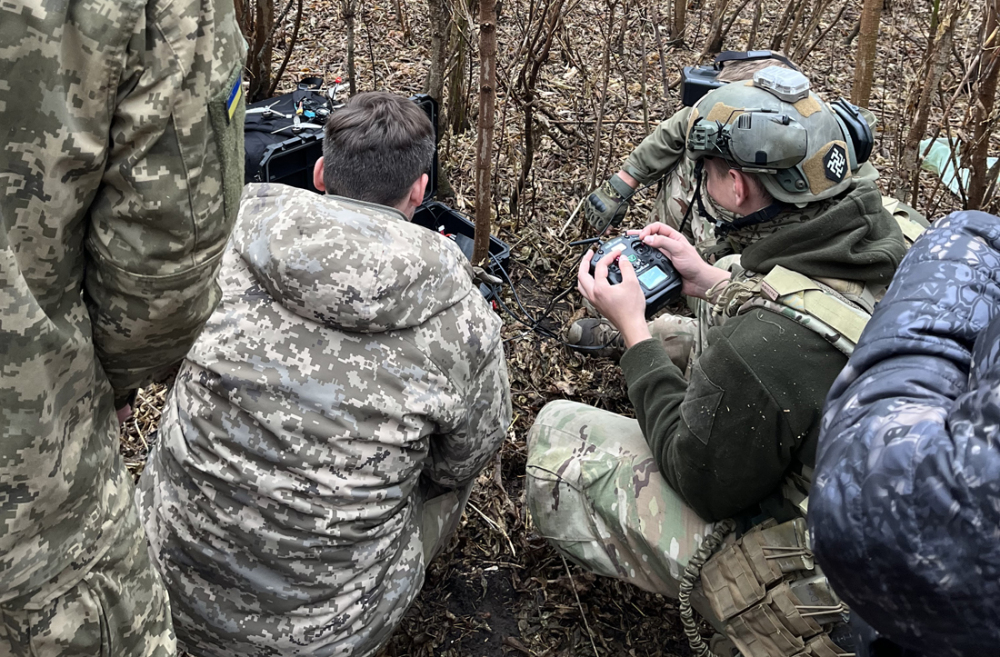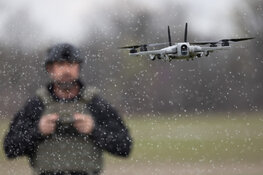Drone technology company Red Cat Holdings Inc. (RCAT:NASDAQ) is watching military hotspots around the globe closely as the drones they make begin to change the very nature of warfare.
A finalist for a new U.S. Army drone program that could be worth upwards of US$1 billion, Red Cat is catching up with a backlog of US$5.1 million in orders, recently received orders for hundreds of drones from a U.S. federal agency and is involved in a US$90 million deal to provide drones for the U.S. Customs and Border Patrol.
The company's Teal 2 drone has also been approved by the U.S. Department of Defense for use across the department and others, and it recently completed a deal selling two of its subsidiaries for US$20 million in cash and stock, which could lead to a possible dividend for investors.
The company's revenues were about US$5.8 million for the fiscal third quarter of 2024. Analyst Ashok Kumar of ThinkEquity predicted rising revenues of US$7 million for Q4 and US$35 million for fiscal 2025.
"The revenues, gross margin, and backlog for the third quarter of fiscal 2024 indicate that Teal 2 is resonating in the marketplace," Kuar wrote in a Feb. 20 note. "The state-of-the-art manufacturing facility in Salt Lake City continues to scale production capacity and refine the manufacturing process."
"With steady growth and a focus on controlling costs, the company can reach breakeven," the analyst continued.
The Catalyst: 'Future of War' Dictated by Drones
According to The Wall Street Journal, unmanned aerial vehicles (UAV) have put lethal and effective weapons in the hands of the Ukrainian military, the Islamic State, and Yemen's Houthi rebels. When Hamas attacked Israel in October, the attack "began with strikes from hobbyist drones on Israeli surveillance posts."
Now, new worries about tension between China and Taiwan are putting more pressure on the U.S. to build up a stockpile of homegrown UAVs to replace models produced overseas, including by China's DJI, which makes more than 50% of the drones sold in the U.S.
"The future of war will be dictated and waged by drones," former Google Chief Executive Officer Eric Schmidt wrote for the Journal after visiting the military in Ukraine. Schmidt is also chairman of the Special Competitive Studies Project and co-author of "The Age of AI: And Our Human Future."
"Costly materiel, such as combat aircraft that are vulnerable to missile attacks, will be replaced by cheaper drones — operating on land, sea, and air," Schmidt wrote. "In the future, like murmurations of starlings, ruthless swarms of AI-empowered kamikaze drones will track mobile targets and algorithmically collaborate to strike past an enemy's electronic countermeasures."
Red Cat's Teal 2 drone, designed as a leading unmanned aircraft system (UAS) for night operations, has been approved through the U.S. Department of Defense and is equipped with advanced high-resolution thermal imaging.
The company is one of two finalists out of dozens of bidders to be awarded a prototype contract of US$2.7 million in the U.S. Army's Short Range Reconnaissance (SRR) Tranche 2 drone program. The company also sees itself as a competitor for the Pentagon's new Replicator initiative to crank out UAVs across "multiple domains" over the next couple of years to counter China's threat.
The company's revenues were about US$5.8 million for the fiscal third quarter of 2024. Analyst Ashok Kumar of ThinkEquity predicted rising revenues of US$7 million for Q4 and US$35 million for fiscal 2025.
"Replicator will galvanize progress in the too-slow shift of U.S. military innovation to leverage platforms that are small, smart, cheap, and many," Deputy Secretary of Defense Kathleen Hicks said last August. "So now is the time to take all-domain, attributable autonomy to the next level: to produce and deliver capabilities to warfighters at the volume and velocity required to deter aggression, to win if we're forced to fight."
Funding for Replicator will come from existing funds and cost "hundreds of millions," ThinkEquity's Kumar noted. He rated the stock Buy with a price target of US$5 per share and noted that the Army's SRR program alone could be worth an "estimated (US)$1.2 billion."
"The Pentagon stated that the U.S. will build thousands of drones, with a 24-month timeline, to counter China's Pacific military threat," Kumar wrote. "Red Cat has the unmanned tech that makes the U.S. military more lethal within two years."
Bloomberg Economics estimated the international price tag of a war over Taiwan at about US$10 trillion, or about 10% of global GDP, "dwarfing the blow from the war in Ukraine, Covid pandemic, and Global Financial Crisis."
"War over Taiwan would have a cost in blood and treasure so vast that even those unhappiest with the status quo have reason not to risk it," Bloomberg noted.
Impressive Results in the Field
Ukrainian fighters have seen success with UAVs, Mykola Bielieskov wrote for the Atlantic Council. The country has set a target of having more than 1 million drones by the end of the year.
"The results have been impressive," Bielieskov wrote of drone use on the front. "During a single week in early 2024, Ukrainian Minister of Digital Transformation Mykhailo Fedorov reported that the country's drone units had destroyed 73 Russian tanks along with air defense systems, fuel storage depots, and multiple other high-value targets."
The country is also using longer-range drones to strike targets deeper in Russia, and marine drones have helped break a Russian naval blockade of Ukraine's Black Sea ports.
"Ukraine's international partners are also focusing their efforts on helping the country stay one step ahead of Russia in the drone war," the author continued. "A coalition of around ten countries recently vowed to deliver (an additional) 1 million drones to Ukraine by February 2025."

Red Cat Chief Executive Officer Jeff Thompson visited Ukraine and saw the drones fighters are using on the battlefield during an ISR (military intelligence, surveillance, and reconnaissance), FPV kamikaze training ride along. (See above.) He noted that many tanks now have metal plates over their roofs because drones would enter tanks when the hatches were opened and blow them up from the inside.
"It's completely changed warfare, taking the (US)$1,000 drone and taking on a (US)$3 million tank," he told Streetwise Reports. "They're averaging killing 300 targets per week with these FPV (first person view) drones."
Climbing Revenue, Possible Dividend
Quarterly revenue has continued to go up for Red Cat, from US$1.7 million in the first fiscal quarter of 2024, US$3.9 million in Q2, and US$5.8 million in Q3. Kumar predicts a rise to US$7 million for the fourth quarter and US$35 million for fiscal 2025.
"With the ongoing shift to small tactical drones in warfare, Teal sUAS is positioned as a premier ISR (military intelligence, surveillance, and reconnaissance) system for the warfighter," Kumar wrote. "The growing backlog and the recent U.S. Army down selection support growth and improving profitability."
Unusual Machines Inc., looking to take on China in providing parts for drone components, recently purchased Red Cat's Rotor Riot LLC and Fat Shark Holdings Ltd. subsidiaries for US$20 million — US$1 million in cash, a US$2 million promissory note and US$17 million of the company's common stock, or 4,250,000 shares.
 Streetwise Ownership Overview*
Streetwise Ownership Overview*
Red Cat Holdings Inc. (RCAT:NASDAQ)
Thompson said he was not sure if the company would issue any dividends to shareholders, but "we think it's a high likelihood that we will."
Ownership and Share Structure
According to Red Cat, 37.27% of the stock is held by management and insiders. Reuters notes that CEO Thompson owns 16.52%, CEO of Fat Shark RC Vision Systems Gregory Ralph French has 6.49%, COO Allan Thomas Evans has 1.82%, and Director Nicholas Liuzza has 1.32%.
Institutional investors have 9.01%. The Vanguard Group Inc. has 1.75%, and Pelion Venture Partners has 1.21%, Reuters reported.
The rest is in retail.
Red Cat Holdings has a market cap of US$53.27 million, with 74.16 million shares outstanding, and trades in a 52-week range of US$1.47 and US$0.525.
| Want to be the first to know about interesting Technology investment ideas? Sign up to receive the FREE Streetwise Reports' newsletter. | Subscribe |
Important Disclosures:
- As of the date of this article, officers and/or employees of Streetwise Reports LLC (including members of their household) own securities of Red Cat Holdings Inc.
- Steve Sobek wrote this article for Streetwise Reports LLC and provides services to Streetwise Reports as an employee.
- This article does not constitute investment advice and is not a solicitation for any investment. Streetwise Reports does not render general or specific investment advice and the information on Streetwise Reports should not be considered a recommendation to buy or sell any security. Each reader is encouraged to consult with his or her personal financial adviser and perform their own comprehensive investment research. By opening this page, each reader accepts and agrees to Streetwise Reports' terms of use and full legal disclaimer. Streetwise Reports does not endorse or recommend the business, products, services or securities of any company.
For additional disclosures, please click here.




































